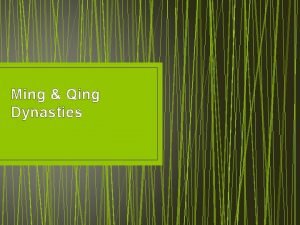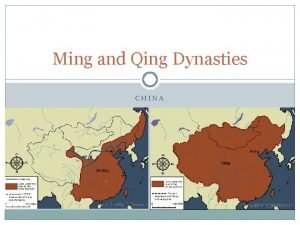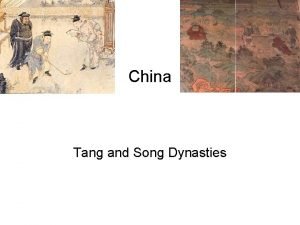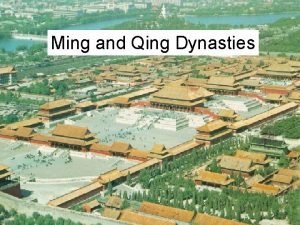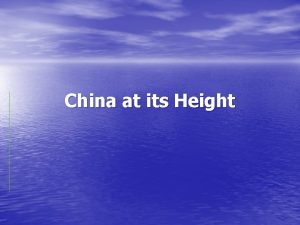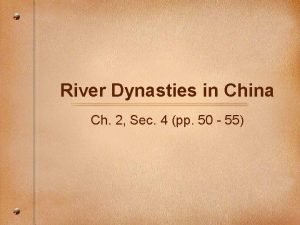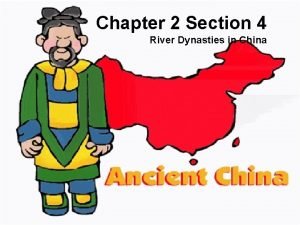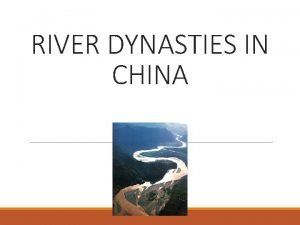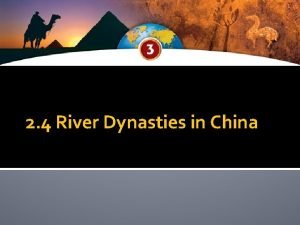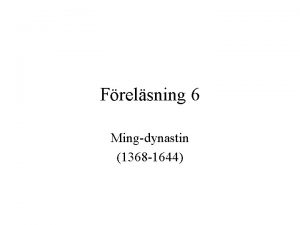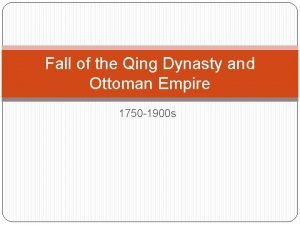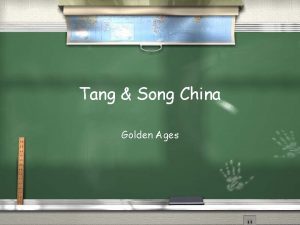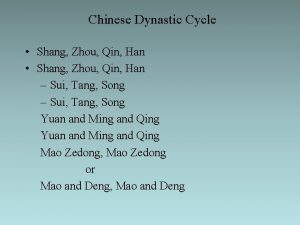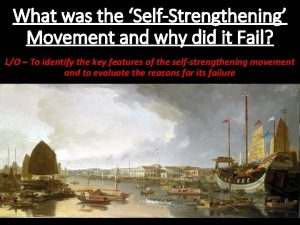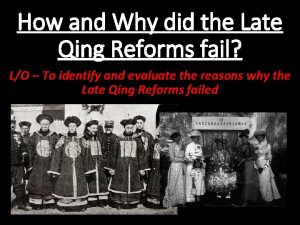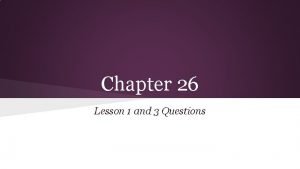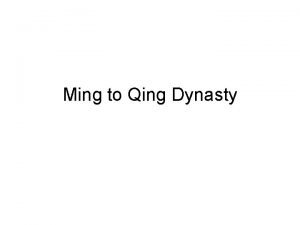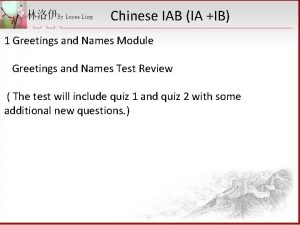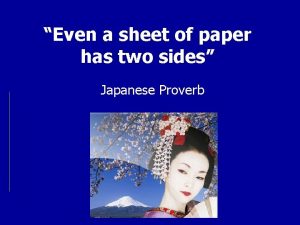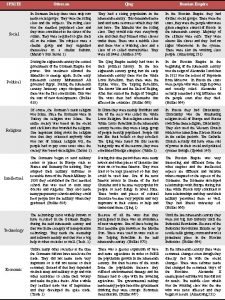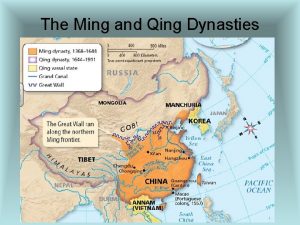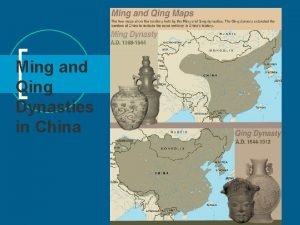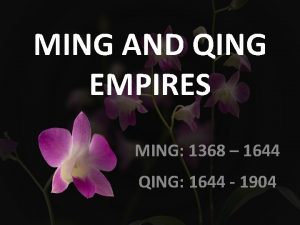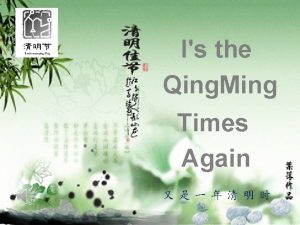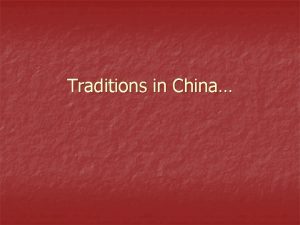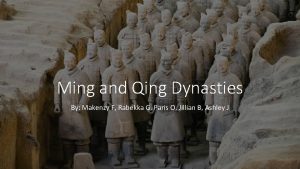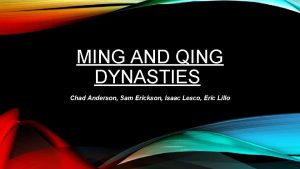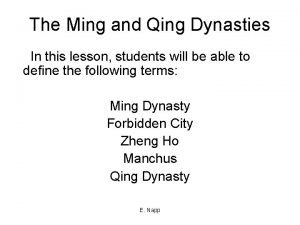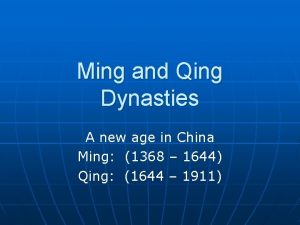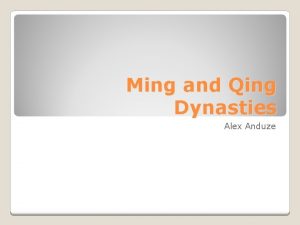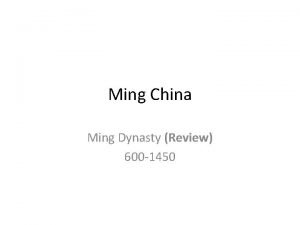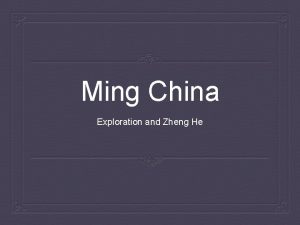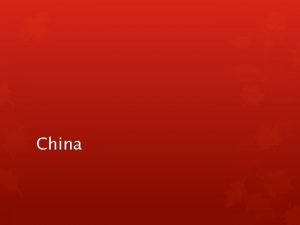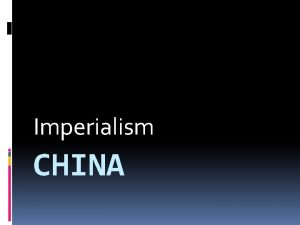The Ming and Qing Dynasties China under Ming

































- Slides: 33

The Ming and Qing Dynasties

China under Ming Rule Ø 1368 - Zhu Yuanzhang and his rebel army overthrew the Mongol empire Ø Zhu took the name “Hongwu” and founded the Ming Dynasty Ø Lasted 300 years until 1644 Ø A period when China gained control over Korea, Mongolia, parts of Central and Southeast Asia

During the Ming Dynasty, China enjoyed nearly three hundred years of stability and prosperity.

Ming China • The Ming dynasty ruled China from 1368 -1644. • Ming ruler improved Chinese society by: - reduce taxes - made improvements for agriculture - rid Mongol influences and corruption - expand the power as emperor - civil service exam system • Yongle replaced Hongwu as emperor and moved capital to Beijing

The Forbidden City • Ming rulers constructed a magnificent Imperial Palace in Beijing. • This Imperial Palace was called the Forbidden City. • It was the home of all later Chinese emperors. https: //www. google. com/maps/d/viewer? mi d=1 p 5 c 1 Lt 3 Whf. ISrix. LRnm. Ld. WMjxmr. P 6 Hy&ll=39. 916814835 134865%2 C 116. 38981997067594&z=16

• The Forbidden City took 14 years to build (from 1406 to 1420). • It was built by over 1, 000 workers, including more than 100, 000 craftsmen. • The Forbidden City of China • It was the imperial palace of China for 492 years (1420– 1912). • It was the home of 24 emperors — 14 of the Ming dynasty and 10 of the Qing dynasty • It covers 0. 72 sq km (0. 28 sq mi), of which (38 acres) are floor area. • It has 980 buildings in over 70 palace compounds, with over 8, 700 rooms. • It is 961 meters long from south to north and 753 meters wide. • It is surrounded by a 10 -meter-high wall, which is 3. 4 km (2 miles) long. • It has a 52 -meter wide moat round it. • It hosts 14 million visitors per year, a maximum of 80, 000 visitors per day.

During the Ming Dynasty, Zheng Ho traveled to India and even Arabia.

Zheng Ho • Early Ming rulers sponsored great naval expeditions. • Zheng Ho was an admiral of the Chinese navy and conducted 7 voyages • He even traveled to India and Arabia.

Compare Zheng Ho’s ship to Columbus’ ship. • Sailed with as many as 300 ships • Demonstrated China’s sea power

Let us not forget……. .

Ming Economy and Society • Ming rule brought prosperity to the country: * improved irrigation techniques * Rice farming * New crops from America- corn and sweet potatoes * Porcelain and Silk became large industries

The Decline of the Mings • Population pressure led to peasant uprisings. • Many Chinese felt the Mings had lost the Mandate of Heaven. • In 1644, the Manchus invaded and conquered China.

Eventually, the Manchus invaded China and overthrew the Ming dynasty.

The Manchu dynasty (last dynasty)was known as the Qing dynasty. It lasted from 1644 -1911.

Initially, the Manchus brought peace to China. They built new roads and cleared additional land for farming but European technology began to surpass China.

Qing Prosperity • Qing dynasty flourished under two Emperors: - Kangxi 1661 -1722 - Qianlong (grandson of Kangxi) 1736 -1796 • Qianlong expanded empire by conquering Taiwan, Mongolia, and Tibet - population boom - Economy thrived

Qing Dynasty (Manchus) (1644 -1911) • Conflict with Europe: “Ocean Devils” • 1793: Relations continued to deteriorate • Both sides think they were economically and culturally superior • Eventually: Opium Wars (which China lost) and the Treaty of Nanjing (British got Hong Kong plus trading rights)

https: //www. youtube. com/watch? v=cqld 9 vg f. A_o

Medieval Japan and Korea

Let us not forget……. .

EMPEROR Emperor • Emperor and imperial family highest on social ladder • Religious leader – Direct descendant of Amaturasu Omikami • Figurehead (leader in name only) – No political Power • Under control of Shogun’s clan • ALL classes of society provided for Emperor and his court. • Emperor still exists today His Imperial Majesty AKIHITO 125 th Emperor of Japan

Shogun • • • Miltary Leader Highest in warrior class Clans fought to acquire this status Political Leader Those of other classes under him provided for his needs • Shogun gave protection and privileges – Portion of land – Produce on land

Daimyo • • Part of warrior class Means “Great Names” Shogun’s representatives Ran estates according to shogun’s rules • Swords most valuable possessions • Used often to demonstrate loyalty to Shogun • Lived in huge castles surrounded by moats

Samurai Satsuma Samurai • • Professional warriors Loyal to shogun and Daimyos Lived in Daimyos castles Fairly high social status but little political power • Needs met by lower classes than them

Seppuku - Ritual suicide: the act of killing one's self by slitting open his belly. Seppuku came to be the 'official' manner of suicide for a samurai, and was prohibited for all other classes. In time, seppuku came to take on religious connotations, but in essence the exceedingly painful manner of dying it brought was a mark of grime pride to the samurai-a final test of his bravery. When a female member of a samurai house committed seppuku, she almost always did so by slitting her own throat

Peasants • • • Largest class Included farmers and fishermen Low social status No political power VERY poor Valued because they produced food for all other classes • Often made material for clothing • Paid taxes with rice and work – Had to pay 2/3 of year’s crop to upper classes • Often starved

Artisans • Craftspeople who made variety of products – – – – Art Cooking pots Fish hoods Farm tools Theatre Ship anchors swords • Great sword makers highly respected • On whole, however, artisans not as respected as peasants because they didn’t produce food

Merchants • Sold goods and produce made by others • Very low social status – Produced nothing of value and lived off the efforts of others’ work • Often made to live in separate locations • Not allowed to mix with other classes except to do business

DRAW THIS !!!!!


https: //www. youtube. com/watch? v=k 3 s. Rz. Y _RXDk https: //www. youtube. com/watch? v=fw. C 0 Q CWh. IX 0

Chapter 3 focused on four Asian empires called the ___1____, ____2__, ___3___, and Feudal _4__. I learned the predominant religion in the western Asian empires was _5__with two groups called the Shiites and __6_. The country that is home to the former Safavid empire is present day _7___. The country home to former Ottoman is _8_____. The country that is home to former Mughal empire is ___9___. In the Mughal empire, the Persian word for Mughal is _10_. Of all the Mughal rulers, the best one was __11_the great. The China empire was cool since they introduced __12__to the other empires causing a big ol “boom” in weaponry. The __13__and the __14__ dynasties were very unique in China. These were the last two dynasties. There was a Chinese admiral named __15__that conducted seven voyages around the Indian Ocean while trading with other regions. Japan’s culture was crazy! They modeled their social system similar to Medieval Europe with some differences. Their figurehead ruler was called an __16__while the real leader was called the____17_______. The sword yielding protector was called the __18_____ and they followed a strict code of ethics (way of the warrior) called _19_______. The most dominant shogunate in Japan was called the ______20_____ shogunate.

Chapter 3 focused on four Asian empires called the Ottoman, Safavid, Mughal, and Feudal Japan. I learned the predominant religion in the western Asian empires was Muslim with two groups called the Shiites and Sunnis. The country that is home to the former Safavid empire is present day Iran. The country home to former Ottoman is Turkey. The country that is home to former Mughal empire is India. In the Mughal empire, the Persian word for Mughal is Mongol. Of all the Mughal rulers, the best one was Akbar the great. The China empire was cool since they introduced gunpowder to the other empires causing a big ol “boom” in weaponry. The Ming and the Qing dynasties were very unique in China. These were the last two dynasties. There was a Chinese admiral named Zheng He that conducted seven voyages around the Indian Ocean while trading with other regions. Japan’s culture was crazy! They modeled their social system similar to Medieval Europe with some differences. Their figurehead ruler was called an Emperor while the real leader was called the Shogun. The sword yielding protector was called the Samurai and they followed a strict code of ethics (way of the warrior) called Bushido. The most dominant shogunate in Japan was called the Tokugawa shogunate.
 Qing qing hardware contacts
Qing qing hardware contacts Ming and qing dynasty
Ming and qing dynasty Ming dynasty time period
Ming dynasty time period Tang vs song dynasty venn diagram
Tang vs song dynasty venn diagram Qing conquest of the ming
Qing conquest of the ming Mingoch
Mingoch How did the sui and tang dynasties reunite china
How did the sui and tang dynasties reunite china Qing china at its height
Qing china at its height China at its height
China at its height Chapter 2 section 4 river dynasties in china
Chapter 2 section 4 river dynasties in china River dynasties in china chapter 2 section 4
River dynasties in china chapter 2 section 4 River dynasties in china
River dynasties in china River dynasties in china
River dynasties in china Spice chart tang and song
Spice chart tang and song The ming dynasty ended rule of china.
The ming dynasty ended rule of china. Hög ämbetsman under ming-dynastin
Hög ämbetsman under ming-dynastin China opium war political cartoon
China opium war political cartoon How was china reunited under the sui dynasty
How was china reunited under the sui dynasty Period of disunion
Period of disunion Golden age of tang and song dynasties
Golden age of tang and song dynasties Han sui tang song
Han sui tang song Sui tang and song dynasties
Sui tang and song dynasties The tang and song eras were a golden age of
The tang and song eras were a golden age of Dynastic cycle
Dynastic cycle Achievements of the tang and song dynasties
Achievements of the tang and song dynasties Self strengthening movement china
Self strengthening movement china Late qing reforms
Late qing reforms Song dynasty social structure
Song dynasty social structure The decline of the qing dynasty
The decline of the qing dynasty Chapter 26 lesson 1 the decline of the qing dynasty
Chapter 26 lesson 1 the decline of the qing dynasty Qing dynasty dbq
Qing dynasty dbq Qing wen nin gui xing
Qing wen nin gui xing Nakanunara
Nakanunara Qing dynasty social classes
Qing dynasty social classes

